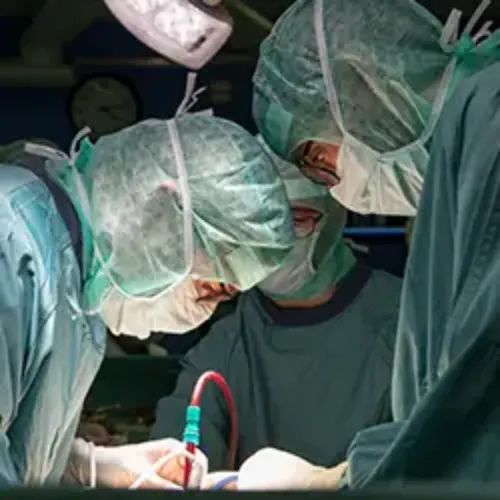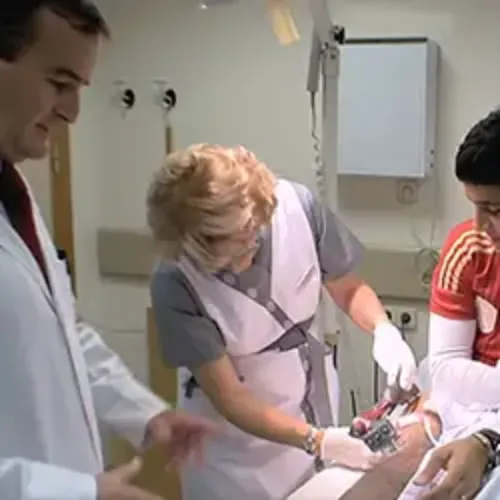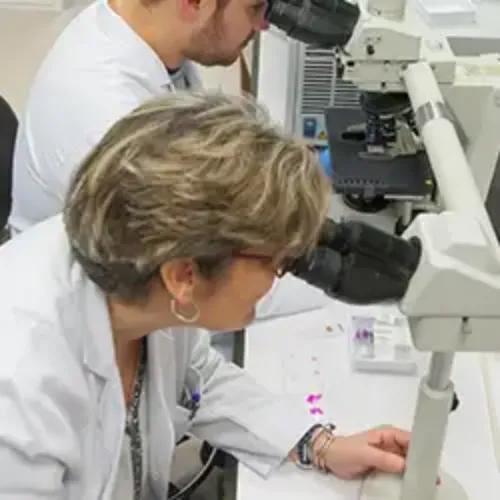Sarcomas Area
"The Clinic has a wealth of experience in the treatment of bone sarcomas with preservation of the extremity. We have a survival rate of around 70% and a limb preservation rate of over 90%".
DR. ALEJANDRO GALLEGO COORDINATOR. SARCOMAS AREA

The Sarcomas Area of the Cancer Center Clínica Universidad de Navarra is one of the most renowned centres worldwide in this field. Its team of professionals is recognised all over the world in this field of medicine.
It was one of the first centres in the world to implement programmes of conservative surgery of the extremity, together with the appropriate adjuvant treatments.
Since 1980 more than 2,000 patients with sarcoma have been treated at our centre. Since it is a very rare pathology, there are a limited number of hospitals with experience in the area. Thus, patients from all regions of Spain and many other countries come to the Clinic.
The Clinic has the most modern and sophisticated means for diagnosing and treating this disease. As with other cancers, early diagnosis and treatment are essential to obtain the best results.
We provide the patient with the most basic anatomopathological and genomic analysis of the lesion, focusing on the individualised treatment that best meets his or her needs. For that purpose, we use the most advanced techniques, which include brachytherapy, hypertermic perfusion of the limb and proton therapy, all combined with the most advanced techniques for surgical resection and reconstruction of the extremity.
The Clinic has extensive experience in the treatment of bone sarcomas with preservation of the limb. We have a survival rate of around 70% and a limb preservation rate of around 95%.

A PERSONALIZED MEDICINE
Second Opinion,
peace of mind
Request a second opinion from our professionals with great experience in the diagnosis and treatment of oncological diseases
In 3 days, without leaving home.
Advanced diagnosis and treatment for better care
It is extremely important that the diagnostic process and the initiation of treatment are as fast as possible.
Delays can determine patient survival.
It is the most common childhood bone cancer, although its incidence is very low (1-2 cases per million inhabitants per year). That is the reason why it is important to carry out such treatments in experienced centres.
It usually affects children and adolescents, and the most frequent location is around the knee. Pain (mainly nocturnal) is the most frequent symptom, sometimes accompanied by an increase in volume of hard consistency.
Early diagnosis and treatment is of crucial importance to achieve the best survival rates and preservation of the limb.
Treatment consists of chemotherapy (at the Clinic we use intra-arterial chemotherapy to improve the response of the tumour) and surgery. The best results are achieved when the response to treatment is good and during surgery the tumour is completely removed. This requires the experience of a multidisciplinary team of radiologists, pathologists, oncologists, paediatricians, orthopaedic surgeons...
We have developed techniques such as epiphysiolysis prior to resection that manage to optimise the result, and which today have been spread worldwide via professionals who have trained at the Clinic.
It is the second most common bone sarcoma that also affects children and adolescents. Part of them are located in the axial skeleton (pelvis, spine, scapula, clavicle, ribs...) and the rest can appear in any bone.
Like osteosarcoma, nighttime pain in a child or adolescent is usually the initial symptom, with or without the appearance of a lump. The sooner treatment begins, the better the chance of cure.
Also in this tumour, the response to chemotherapy treatment is very important (although the drugs used are different from osteosarcoma) and good surgery which, in locations such as the pelvis or spine, is much more demanding than in the extremities. In some cases radiotherapy is also used.
In 80% of our cases, preoperative chemotherapy achieves rates of necrosis of the tumour close to 100%, which greatly facilitates its surgical resection.
An adult bone tumour can arise from a previous benign lesion (osteochondroma or chondroma) of childhood, or appear "exnovo". It can also produce night pain and the appearance of a hard lump of rapid growth.
It usually does not respond to chemotherapy or radiotherapy and therefore the main treatment is surgical. Some low-grade chondrosarcomas can be treated with very mild surgery, while high grade (II and III) require extensive surgery. Axial location chondrosarcomas require complex surgery.
It is a tumor of the epiphyses (the joint area) of the long bones. The most frequent locations are the knee and the wrist, in young adults (20-40 years old). It is a benign tumour, although locally aggressive.
The treatment was exclusively surgical until a decade ago, when a useful medication (Denosumab) was discovered in this tumour. Nowadays we use it as a previous treatment to facilitate surgery.
In most cases they are treated with curettage surgery (preserving the joint) and some adjuvant (liquid nitrogen, phenol, etc) to avoid recurrence.
This is a very heterogeneous group of tumours affecting the "non-bone" part of the locomotor system of the extremities and trunk. There are more than 60 different types, although the most common are those of the fatty lineage (liposarcomas), fibrous lineage (fifrosarcoma or fibrohistiocytoma), synovial sarcoma, neural lineage (schwanosarcomas), etc.
These are typical of adults and they are usually not very painful. The most frequent is the appearance of a lump of elastic consistency on a limb. The criteria for suspecting soft tissue sarcoma (when a lump appears) are:
- Lump with a diameter greater than 4-5 cm (like a golf ball).
- Painful.
- Rapid growth (weeks).
- Deep to the fascia.
- Even without having any of the previous characteristics, a lump that is removed and reappears.
Diagnosis requires imaging techniques (MRI and PET are especially useful). A biopsy is necessary to confirm clinical suspicion.
The pathologist must also be an expert to be able to distinguish between some sarcomas and others, and to classify them according to their aggressiveness (high grade or low grade).
The most effective therapeutic weapon is complete resection of the tumour. Radiotherapy is indicated in most large and deep tumours of the fascia, whereas chemotherapy is occasionally applied to high grade sarcomas. The prognosis depends on the extension at the beginning, the size of the tumour and the histological grade.
In hands of expert, the cure rate is around 80%, with the limb being preserved in the vast majority of cases.
Experienced surgeons must operate them on. Radiotherapy is effective in large or deep fascia tumours, whereas chemotherapy has little efficacy, although it is used in high grade metastatic tumours or as prevention of possible metastasis.
They are 3 times more frequent than bone sarcomas and are often under-diagnosed and treated by inexperienced doctors from different specialities. This means that in countries where these cases are not treated in experienced centres, the cure rate is much lower.
Do you need to request a consultation with one of our specialists?
SPECIALISATION
The value of experience
At the Clínica Universidad de Navarra, we have treated nearly a thousand malignant primary bone tumours over the last twenty years. In osteosarcoma, to cite the most common, the survival rate is 74% at 10 years, with a limb preservation rate of over 90%.

Precision surgery
In order to cure a malignant bone tumour it is necessary to remove the entire lesion, including the path of the previous biopsy. This is the reason why it is necessary for that biopsy to be performed by the surgeon who will carry out the definitive operation.

Teamwork
It is necessary to unite everyone's efforts in order for each patient to be treated by a team that discusses and follows each case in particular in order to avoid any delays that may condition the effectiveness of the treatment.

Experience
The Clinic is one of the European centres with the greatest experience in musculoskeletal tumours and that offers one of the highest rates of preservation of the patient's limb in the world.

Why choose the Clinic?
- Integral evaluation of the patient.
- Cutting-edge technology.
- International reference professionals.
Our team of professionals
We keep on everyday researching in order to find solutions
Research against
musculoskeletal tumors
The Neuro-oncology, Sarcomas and Pediatric Tumors Research Area seeks to find innovative treatments that will make it possible to surpass the cure rate obtained to date.
As a result, there are numerous publications, many of them in collaboration with the most renowned researchers worldwide in this field.
Participation in these trials provides patients with new possibilities by allowing access to the latest therapeutic advances

































